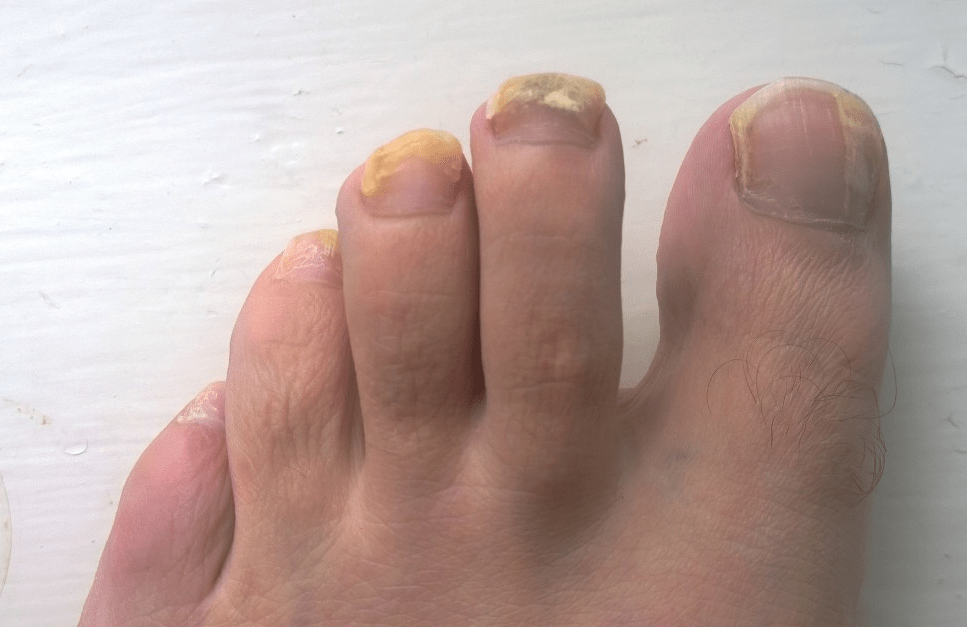Toenail fungus, also known as onychomycosis and tinea unguium, is an infection that usually happens in the nails on a human’s foot.
This infection can cause discoloration of the nail, as the once healthy and translucent color of it will turn into a pale yellow or an opaque white. Also, the infected nail will start to crumble after applying no treatment to the infection, which leads to inflammation and other skin diseases like cellulitis and athlete’s foot. Onychomycosis can occur in the fingernails, but it is more commonly seen in toenails.
As its name implies, toenail fungus is brought about by many different species belonging to the fungus kingdom, but the most common fungus to infect the nails is the dermatophyte Trichophyton rubrum. There are three different types of dermatophyte fungi; the first is the Triciphyton, which is the one that causes toenail fungus, while the other two are Microsporum and Epidermophyton.
Besides the Trichophyton rubrum, nondermatophytic molds and Candida can also inflict onychomycosis to nails. For quick relief against toenail fungus, use Fungonis Gel.
Types of Toenail Fungus
Because there can be various pathogens to the infection, researchers have divided toenail fungus into four types that have different causes and effects on a person’s nails.
Distal Subungual Onychomycosis
The most common type of toenail fungus, the distal subungual onychomycosis is caused by the Trichophyton rubrum, which typically lives under the distal plate of the nail and on the nail bed.
Candidal Onychomycosis
Candidal Onychomycosis occurs after the fingernails are invaded by Candida, a genus of yeasts that has specific species that can infect other parts of the body such as the tongue and the vagina. This type of toenail fungus is not as frequently seen as the first type mentioned previously because the nails need to be infected by other pathogens first before they can start invading.
Proximal Subungual Onychomycosis
This type of toenail fungus appears when fungi enter a nail plate and subsequently infecting its nail fold. The proximal subungual onychomycosis is rarely seen as the ones usually inflicted with the infection are living with a compromised immune system.
White Superficial Onychomycosis
The second most common type of toenail fungus, the white superficial onychomycosis, also known as WSO, occurs when fungi invade only the surface layers of the nail plate. Since they can’t completely penetrate every part of a nail, they will only appear as tiny white spots on top of the plate and will not turn the nails yellow.
Treatment for Onychomycosis
Toenail fungus is quite common, and as such, people don’t often consider it as a serious condition and just let it remain on their toes without any medications. However, onychomycosis that has been on the toes for months or years can cause your nails to fall off of your toes. In some cases, the nails may not grow back, which leads to more complications to the nail bed and the skin near or on your toes like inflammation and infection.
To prevent the infection from worsening, it is best to consult your doctor and know what he or she can prescribe medicines for your toenail fungus.
Oral Medication
Most doctors would recommend drugs that can be taken orally like Sporanox (itraconazole) and Lamisil (terbinafine) that help your toes grow healthy new nails to replace the infected ones. Both drugs normally are taken for up to 12 weeks, depending on how severe the condition is. Also, you would have to wait at least four months to see significant improvements on your nails as they could take a while to grow.
However, these drugs can have side effects for people with liver or heart problems. You should inform your doctor first if you have existing problems in other parts of your body before he or she can prescribe medication.
Topical Medication
Besides taking drugs orally, there are also a few products that can be applied topically to alleviate the symptoms of toenail fungus. The first product is a nail cream that you can use on the infected toenails after they are softened by soaking in water. To improve the effects of nail cream, your nails would have to be thinned first by either yourself using a urea lotion or by your doctor by using a medical nail file.
For those who need to take the said drugs but wanted to hide the infection when wearing slippers or sandals, there are several nail polishes available in the market that have antifungal properties to help heal the disease while conveniently hiding it from other people. The most well-known type of medicated nail polish is called Penlac, which you can apply at least once a week for better results.
If you have onychomycosis, don’t let the infection stay on your toes and apply medication immediately once it shows symptoms. Conditions like toenail fungus can often lead to worse complications, so don’t let even the smallest imperfections in your body go unnoticed.

